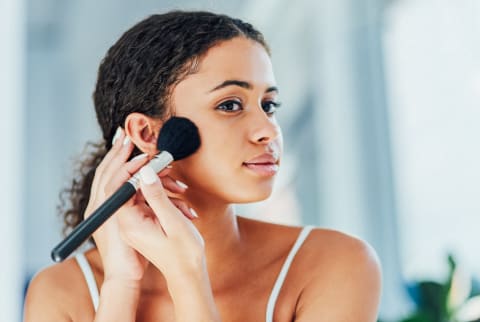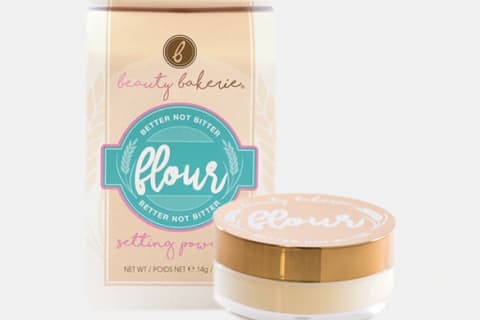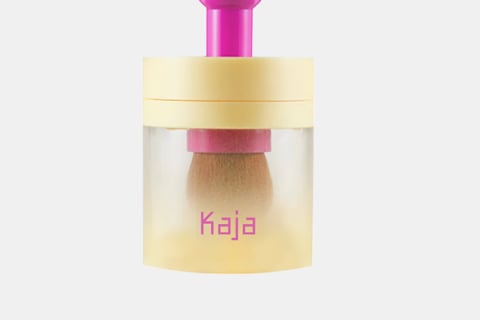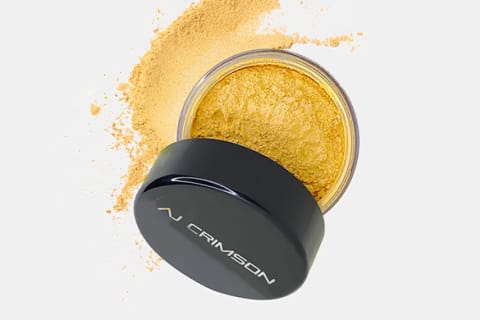Banana Powder Is Beloved For Matte Makeup: How To Use It Like A Pro


We love dewy, luminescent makeup around here, but when someone perfects a matte moment, we're more than ready to holler our praises. That's because absolutely nailing shine-free makeup is, well, difficult—when packing on powder, there's a finely milled line (had to) between a smooth, pillowy finish, and one that creases or appears caky.
One of the most coveted secrets to achieve matte makeup greatness? Banana powder.
What is banana powder?
"Banana powder was developed with the intention of being a universally flattering color-correcting and brightening setting powder," says makeup artist Jenny Patinkin. "It can help set makeup in place and control shine while also neutralizing redness or discoloration in the skin and simultaneously giving a brightening effect."
A quick history lesson: Banana powder actually used to be a film industry secret before Ben Nye, a makeup director for 20th Century Fox, created the very first consumer product (which you can still snag today). Nye used this setting powder on just about every iconic Hollywood star—Marilyn Monroe, Paul Newman, and Julie Andrews, to name a few—in order to highlight their features and keep their makeup looking immaculate under hot stage lights. It quickly became a staple in the drag community as well, again for its ability to help makeup stay put during long performances.
Fast-forward to the 2010s, when banana powder was a beauty bag staple for amateurs and professionals alike (many point to celebrity makeup artist Mario Dedivanovic, for propelling it into the spotlight by showcasing detailed contouring tutorials): Now, banana powder isn't reserved only for in-the-know entertainers and professionals but for anyone yearning for a cushioned, matte look.
Who should use it?
Banana powder has a yellow-golden hue (hence, its name), so it typically flatters those with warm, golden, or olive undertones. "One would want to use a yellow powder to bring out and highlight the undertones to the skin," notes celebrity makeup artist A.J. Crimson.
So for those with cooler undertones, banana powder simply won't work: "It's like any color corrector," says Patinkin. "If you apply it where you don't need it, or it doesn't meld with the natural tones of your skin, it can give you a very odd tonality."
How do you use it?
Same as you would any other setting powder: wherever you'd like to color correct, mattify, or improve wear time. Makeup artists typically recommend the T-zone, as that's where most people accrue the most oil, or you can dust it anywhere you want to brighten (like the top of the cheekbones and under the eyes). "I recommend not applying it (or any powder) all over the face," says Patinkin. Even for a matte look, you want to keep some dimension to avoid looking flat.
You can always just press a bit of powder on any areas you want to control shine, but if you want to try a baking technique (for extra-long wear), here's a guide:
- After applying your highlight and base products, use a beauty sponge to pack the banana powder onto the places you want to mattify and brighten (under the eyes, the cheekbones, the chin, etc.).
- Leave the powder for five minutes, letting it set and soak up excess oil.
- After the few minutes are up, use a fluffy brush to dust away the extra powder that's left. And there you have it: a bright, matte base that won't budge.
Banana powder vs. translucent powder vs. setting powder.
OK, so here's the thing: All of these products are technically the same. They're each classified as a loose, finely milled powder, but the only difference is the color. "The color is its defining trait," notes Patinkin. As Crimson reminds us, banana powder's yellow hue is meant to "brighten with warmth and diffusion," while a translucent powder sets the makeup without adjusting the shade. Or, you can simply grab a flesh-toned setting powder in your exact hue.
No matter which powder you choose, the texture and finish are the same—you can use any of the three to mattify; it just depends on the color payoff you're looking for.
The takeaway.
Banana powder is beloved for setting makeup while offering a bright, warm glow. While its golden pigment typically works for those with warmer undertones, experts throughout history swear by its ability to add warmth to the face and brighten up features—all while keeping makeup in place and zapping shine.

Jamie Schneider is the Beauty Editor at mindbodygreen. She has a B.A. in Organizational Studies and English from the University of Michigan, and her work has appeared in Coveteur, The Chill Times, and more. In her role at mbg, she reports on everything from the top beauty industry trends, to the gut-skin connection and the microbiome, to the latest expert makeup hacks. She currently lives in Brooklyn, New York.



